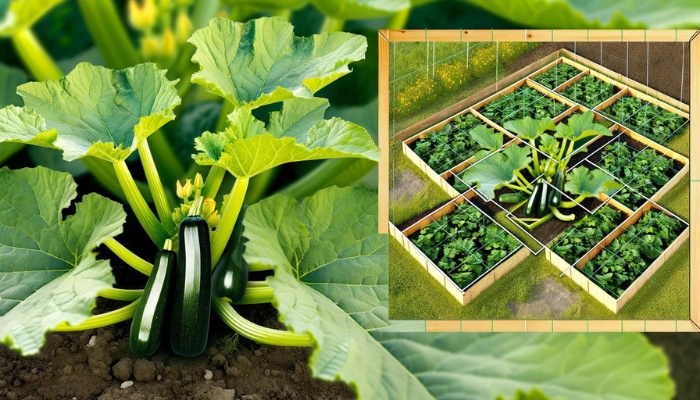You’re about to discover that with the right techniques, growing zucchini in the limited confines of a square foot garden bed is indeed possible and well worth the effort.
From preparing your square foot bed and training the zucchini plants to grow upright to the joy of harvesting, each step is important for success.
Preparing Your Square Foot Bed
Before planting, properly prepare your square foot bed to ensure optimal growth conditions for your zucchini. Soil enrichment and selecting the right bed location are key steps that shouldn’t be overlooked.
Start by choosing a location for your bed that receives at least 6 to 8 hours of sunlight daily. Zucchini thrives in well-lit areas, and the right amount of sunshine is critical for their growth and fruit production.
Next, focus on soil enrichment. Your soil should be rich, loamy, and well-draining to support the zucchini’s need for nutrients and moisture.
Consider incorporating a mix of compost, peat moss, and vermiculite to achieve the ideal soil structure and fertility.
Planting Zucchini Seeds
Now that your square foot bed is richly prepared, it’s time to plant your zucchini seeds. Seed selection requires careful consideration.
Opt for seeds that are known for their robust growth and disease resistance. Look for varieties that thrive in your local climate and soil conditions to ensure a fruitful harvest.
When planting, sow the seeds directly into the soil to avoid the shock of transplanting, which can affect growth.
Plant two seeds per square foot, pushing them an inch deep into the soil. This depth ensures optimal conditions for germination, which typically occurs within 7-10 days.
Keep the soil consistently moist but not waterlogged because too much water can rot the seeds before they have a chance to sprout.
After planting, mark the spot with a label, noting the variety and the date of sowing. This helps in tracking the germination time and future care.
Germination time can vary slightly depending on soil temperature and moisture, so don’t worry if your seeds take a couple of days longer. Patience is key in this initial stage of your zucchini’s journey.
You can remove the weaker of the two seedlings after they emerge.
Managing Zucchini Growth

Once your zucchini seeds have sprouted, manage their growth to ensure a bountiful harvest. The key here isn’t just to let nature take its course but to actively guide your plants toward optimal health and productivity.
This involves a combination of pruning techniques, trellising, and pest control measures that, when done correctly, can significantly boost your yield.
Pruning Techniques
Start by removing any leaves that look yellowed or diseased to prevent the spread of infections. As your plants grow, thin out the foliage to improve air circulation. This helps to minimize the risk of fungal diseases that thrive in damp, poorly ventilated conditions.
Prune any overcrowded fruit to ensure the remaining zucchinis can grow to a healthy size.
Growing Vertically
Zucchini plants are known for their sprawling growth habit, which can take up a lot of space on the ground. By training them to grow upwards, you can save valuable garden space, making it ideal for square foot gardening setups.
Growing zucchini vertically improves air circulation around the plants, which helps to reduce the risk of fungal diseases, and vertical plants are easier to inspect for pests and diseases.
Keeping the fruit and leaves off the ground reduces the risk of soil-borne diseases and can help deter some pests. Harvesting is also more convenient when you don’t have to search through dense foliage on the ground.
- Choose the Right Support: Use sturdy supports like trellises, cages, or strong netting. Zucchini plants can become quite heavy, so the structure needs to be robust enough to support the weight of the plant and its fruits.
- Planting: Position the support structure close to the plant at the time of planting to avoid disturbing the roots later.
- Training the Plant: As the zucchini plant grows, gently guide it onto the support structure. You may need to use soft ties or clips to secure the plant to the support without damaging the stems.
- Pruning: Prune any lateral branches that are too far from the support structure to encourage vertical growth. Be careful not to over-prune as the leaves are necessary for photosynthesis.
- Regular Care: Continue to provide the plant with regular water, sunlight, and nutrients. Monitor for pests and diseases and take action as necessary.
Pest Control
Keep an eye out for common pests like aphids and squash bugs. Early detection is key, so inspect your plants regularly.
You can use organic pest control measures such as neem oil or insecticidal soap to safely deal with infestations without harming your plants or the environment.
Applying a layer of mulch around your plants helps retain soil moisture, suppresses weeds, and can also deter some pests.
Harvesting and Enjoying
Harvesting your zucchini at the right time is critical for the best flavor and texture. Typically, zucchinis are best when they are about 6 to 8 inches long. This size ensures they are tender and not overly seedy.
Use a sharp knife or shears to cut the zucchini off the vine, being careful not to damage the plant for future growth.
Enjoy trying a variety of delicious zucchini recipes because you’ll likely be harvesting more zucchini than you thought possible.
From savory dishes like zucchini noodles and stuffed zucchini boats to sweet treats like zucchini bread and muffins, the versatility of zucchini is unmatched.

